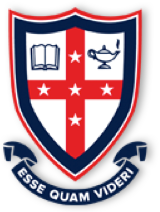Stories
Martin Sharp (OC 1959), Artist
Visionary pop artist Martin Sharp (1942–2013) attended Cranbrook from 1949 until 1959. His father had been one of the earliest students at Cranbrook, having attended from 1919, and his grandfather, Walter Ramsay Sharp, was on the provisional committee that had established the school.1 Sharp had lived close by in Bellevue Hill, but from the age of twelve he had become a boarder due to his parents’ deteriorating relationship.2
Sharp did not always have a good time at Cranbrook. Boarding school life didn’t suit him, nor did the discipline regime involving caning that was the norm in the 1950s, or what he later described as the victimising behaviour of some of the senior boys towards the junior boys.3 However, some of his best and fondest memories at Cranbrook concerned Art Master, Justin O’Brien (see a profile here). The art room had provided a “sanctuary”, and Sharp would later see it as planting the seeds of his artistic career. Art was a compulsory subject at Cranbrook in the 1950s, and it was also offered as an extra-curricular activity. Sharp recalled how Justin O'Brien provided the boys with a “dynamic art painting scene” that felt a world away from other classes.4
In a recently published biography, Martin Sharp described one of the first moments at Cranbrook in which he recognised the power of painting to impact people. Sharp had been painting a portrait for art class of an English policeman or ‘bobby’. As he worked, he found that the portrait had metamorphosed. He explained: “Somehow it turned into the toughest teacher in the school called Mr Bell—Cheery Bell, his nickname was. I did this painting of Cheery Bell with all the kids sitting at their desks. If you didn’t bring your books you’d have to polish the bookshelves and I painted myself—or a boy equivalent to me—polishing the shelves in the background. No one had ever painted teachers before—real people.”5
The Art Master, Justin O’Brien, subsequently hung Martin Sharp’s “cheeky portrait eye-height, halfway up the stairs”. It had been O’Brien’s initiative to “exhibit the best student pictures around the school corridors” at the time. For students, being selected for this honour was as good as winning a prize. The ‘best picks’ were “exhibited in the stairwell, positioned where every teacher and boy saw them as they walked up or down the stairs”. Sharp recalls a crowd gathering around his picture of “Cheery Bell—they were jam-packed around the picture”. It caused quite a stir. “I knew I was onto something”, recalled Martin; “that’s where one learned about the significance of exhibiting. First goal that one!” Far from being insulted, Cheery Bell was flattered enough to want to obtain the picture. The sale of the painting was negotiated through Justin O’Brien.6
O’Brien’s influence on Sharp’s career continued after Cranbrook: they remained friends, and Sharp dropped in to see him from time to time before O’Brien left Cranbrook to live and work in Europe. Sharp had followed O’Brien’s advice in 1960 to enrol in the National Art School, where he met “lots of great people”, including Richard Neville who would become his colleague in the next chapter of his career at the now infamous magazine Oz.7
Sharp had wanted to be many things, including an architect, a singer, and a surfer, but he ultimately pursued art because “there was nothing else that I was any good at”.8 After college he would rise to fame as a pop artist, becoming art director for Oz and designing much of its artwork. He would also design famous album covers and posters, for artists such as Bob Dylan and Jimi Hendrix.
Sharp established art collective The Yellow House in the early 1970s, a hub for visual artists in Potts Point which would eventually be transferred to his own house, Wirian, in Bellevue Hill. He also began a project to revitalise Sydney’s beloved Luna Park in the 1970s, which was then in danger of closing, and which he fought to save in the wake of the tragic Ghost Train fire in 1979.9
Sharp's work has since appeared in many exhibitions including a special Yellow House exhibition at the Art Gallery of New South Wales, and a major retrospective at the Museum of Sydney in 2009–2010. He sadly passed away from emphysema in 2013. Shortly before his death, fellow Cranbrookian and lifelong friend Peter Kingston (see a profile here) said of Sharp, "Martin has a beautiful line – he can pick up a pen and draw anything. I do regard him as a great artist, one of our finest." 10
- 1. Lowell Tarling, Sharp, 1942–1979: A Biography of Martin Sharp as Told to Lowell Tarling (Exile Bay: Ett Imprint, 2016), p. 17.
- 2. “Obituary, Martin Richie Sharp AM, 1942–2013, At Cranbrook 1949–1959”, in The Cranbrookian, Issue 3, 2014, p. 39; and ibid, p. 17.
- 3. This is elaborated on in Martin's biography, including incidents of bullying and one of “molestation”. The latter was dealt with by school administrators but Martin described himself as angry that the alleged perpetrator later ended up a prefect: Tarling, Sharp, Road to Abraxas, op. cit., pp. 18–19.
- 4. Ibid, pp. 20–21.
- 5. The story is an extract from ibid, p. 25. The teacher referred to as "Cheery Bell" was presumably the long serving English teacher C. A. Bell, who taught at Cranbrook from 1932 to 1956: see Malcolm Dan, Remembering C. A. Bell: A Twentieth Century Schoolmaster (Bellevue Hill, Cranbrook School and Melbourne Grammar School, 2009).
- 6. Loc. cit.
- 7. Ibid, p. 32.
- 8. Ibid, p. 33.
- 9. Sean O’Brien, “The Everlasting World of Martin Sharp”, ABC Open, 2 December 2013, accessed online at https://open.abc.net.au/explore/60877, extracted on 22 February 2018. Sharp also continued to fight for its victims: see Joyce Morgan, “Interview: Martin Sharp”, The Sydney Morning Herald, 2 June 2012.
- 10. Joyce Morgan, “Interview: Martin Sharp”, op. cit.

